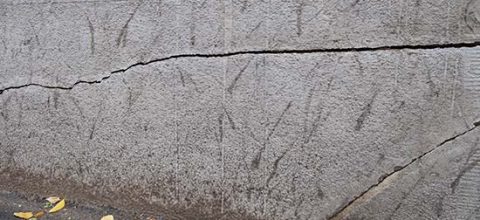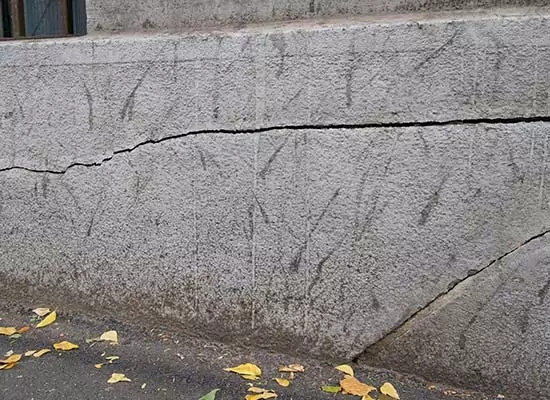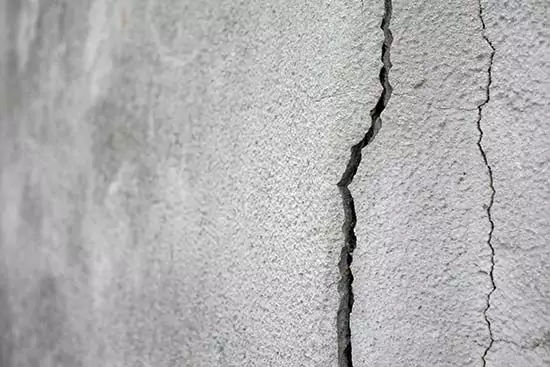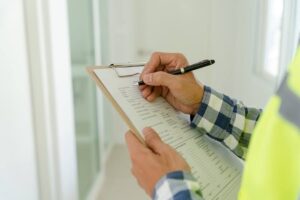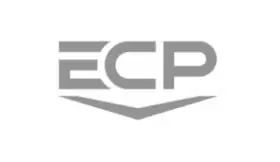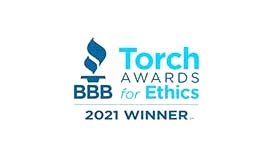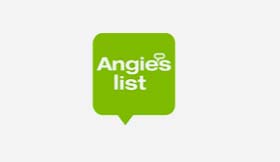We hate to be the bearer of bad news, but yes, you should worry about horizontal foundation cracks. Horizontal foundation cracks – compared to vertical ones – are almost always structurally significant. In other words, they will affect your home’s structural integrity if they aren’t repaired. The good news is horizontal foundation cracks can almost always be repaired.
This article will go over what causes horizontal foundation cracks, how horizontal cracks differ from vertical cracks, when you should start worrying about a horizontal crack, repair techniques for horizontal cracks, and more.
What Causes Horizontal Foundation Cracks
Horizontal foundation cracks are usually caused by hydrostatic pressure. When the soil around the foundation gets saturated with water that can’t drain off, hydrostatic pressure builds up and exerts a tremendous force against foundation walls. The walls will eventually crack and even bow inward if the pressure isn’t relieved. Concrete block foundation walls are especially susceptible to this lateral pressure.
Horizontal cracks are also sometimes caused by something heavy on the ground next to the foundation wall—for example, a big truck parked in a driveway or a dumpster.
If you live in a cold climate, frost heave can also cause foundation cracks. This happens when the soil expands as it freezes and pushes against the foundation wall.
Since foundation walls are load-bearing, foundation cracks threaten the home’s structural integrity. They shouldn’t be ignored.
For more information see, Normal Foundation Cracks: Is There Such a Thing?
Foundation Cracks Vertical vs. Horizontal
Unlike horizontal foundation cracks, vertical cracks usually do not affect the building’s structural integrity. This is why we say that horizontal foundation cracks are structural and vertical foundation cracks are non-structural.
Horizontal Cracks
As we noted above, horizontal foundation cracks are structural in that they can affect your home’s structural integrity. For this reason, they’re considered more serious than vertical foundation cracks. All horizontal foundation cracks need immediate attention from either an experienced foundation repair contractor or a structural engineer.
Vertical Cracks
Vertical cracks are often hairline and are mainly caused by shrinkage during the concrete curing process. While they aren’t considered structural, that doesn’t mean they’re harmless. Vertical hairline cracks can allow water to seep into your basement or crawl space, and hydrostatic pressure can even push water through invisible cracks in the foundation wall. In other words, cracks you didn’t even know were there. So, vertical cracks should be sealed.
Note: If the vertical cracks are wider than hairline or you have many vertical cracks next to each other, it may be something more serious.
When Should You Worry About a Foundation Crack?
You should worry more about horizontal cracks because they’re almost always structural. While you shouldn’t ignore vertical cracks, they don’t merit the same level of concern as horizontal cracks because they’re usually not structural.
You should be concerned about…
- Horizontal foundation cracks, with or without bowing – These need immediate attention.
- Stair step cracks in brick or masonry – Stair step cracks are another sure sign of structural damage.
- Cracks that are over 1/8 inch wide
- Cracks that are wider at one end
- Cracks that are getting bigger – You should monitor even hairline cracks to make sure they’re not growing. Mark the ends of the crack and date them. Measure the width as well and date that. Do this every month to see if they’re getting bigger. Diagonal cracks – These often appear at the corners of windows and doors.
- Diagonal cracks – These often appear at the corners of windows and doors.
- A crack that goes across the ceiling and down a wall
- Many vertical cracks next to each other – As we noted above, a single, hairline vertical crack is almost always nothing to worry about. However, a series of vertical cracks next to each other signifies something else is happening.
If you see any of the above or even something else that you find suspicious, contact a foundation repair contractor immediately for an inspection. Foundation problems get worse over time and will cost more money to repair if you wait.
How To Repair Horizontal Foundation Cracks
Depending on what caused the crack, horizontal foundation cracks can be repaired in various ways including, but not limited to:
Wall plate anchors
Wall plate anchors are used to repair cracked and bowed foundation walls. A wall plate attached to the inside basement wall is connected – via a steel rod – to an anchor buried in the yard. Tightening the rod pulls the wall back.
Resistance push piers
If the horizontal foundation cracks were caused by differential settlement (see below graphic), resistance push piers may be the recommended repair solution. Steel brackets are attached to the foundation’s footer, and the piers are driven through the brackets until they reach load-bearing soil. Once they’re in place, synchronized hydraulic jacks lift the building, closing the cracks.
Helical piers
Although helical piers are commonly used for construction projects requiring a deep foundation, they also strengthen a foundation experiencing differential settlement. They’re turned into the soil to the necessary depth, and then synchronized hydraulic jacks raise the house, closing any cracks.
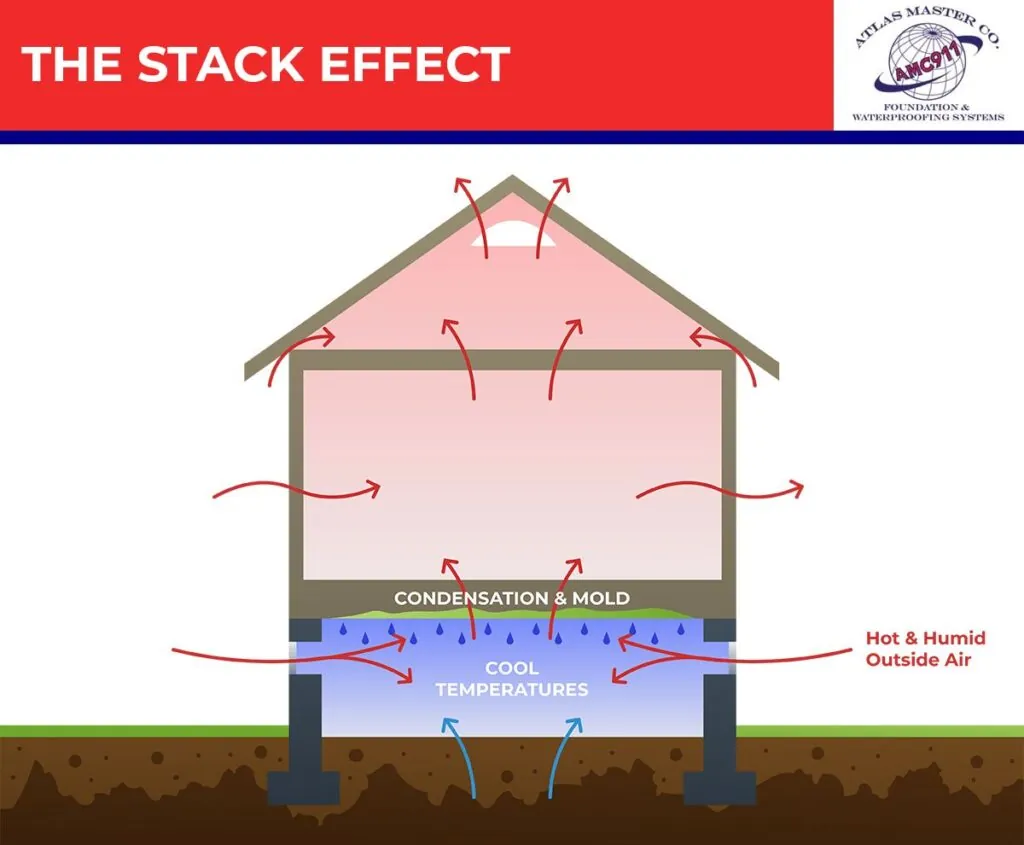
How To Prevent Horizontal Cracks
Since water causes most foundation problems, including horizontal cracks, you can help prevent cracks by getting groundwater around your home’s foundation under control:
If necessary, regrade your yard
The yard around your home should slope away from the foundation. If it doesn’t, water will drain toward the foundation, and this could eventually lead to foundation trouble, including horizontal foundation cracks.
Make sure your gutters aren’t clogged
Clean your gutters regularly, so water gets properly channeled toward downspouts. You don’t want water to spill over the side of the home and into the soil next to the foundation.
Use downspout extensions
If your downspouts are too short, they’ll release water next to the foundation. Extensions are easy to install and channel water away from the foundation before releasing it.
Consider an underground downspout and bubbler pot
Water from gutters flows into an underground downspout. From there, it gets channeled toward a small pit in your yard around 10 feet from your foundation. When the basin in the pit fills with water, it pops up and releases the water away from the foundation.
Install a drain tile system
A drain tile system is the best way to prevent excess moisture from building up in the soil around the foundation. Water flows into a buried drainage pipe and gets channeled toward a sump pit. When the sump pit’s full, the sump pump turns on and releases water away from the foundation.
Keep vegetation away from the foundation
Water-hungry flowers and shrubs should be kept several feet from your foundation. You don’t want a reason to add more water to the soil around the foundation.
If you’re worried about one or more horizontal foundation cracks and you’re in our service area, contact us today for an inspection and repair estimate.


